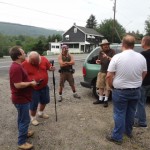“Ghost Hunting”, as opposed to a socially-controlled and culturally-contextual exploration of haunted space, is mostly a state of “mindless” wanderings. It is a “hunt”, usually without much structure, for “something”. A “hunting” type of mentality initiates a number of actions, pursued as a consequence of an assumed link between material manifestations (such as “orbs”, shadows), recordings (EVP), certain measurements (ion, humidity, temperature, EMF), and the “dead”. This desire creates a network between people (“ghost hunters”), things (paranormal manifestations), and popular contemporary (not past) social events (“ghost tourism”, “para-celebrity meets”) that carry particular (and “loaded”) meanings. This is because this “ghost hunting culture” has become a central part of what it means to be accepted into this popular contemporary trope.
Being a part of this contemporary social manifestation (or its “leadership”) has value to its participants because it is perceived to contain a compressed and “worthy” sense of elitism and popular culture “aristocracy”, the great tale of that 15 minutes of fame. That is why “My Ghost Story” is a popular manifestation of this contemporary trope. It also assumes a much-told tale (through social media) of an ability to encapsulate and “bottle” (for public consumption and approval) changes to and power relations in the field of “legitimate” paranormal research. These exaggerated (and “false”) senses of pride, status, and power politics play a crucial role in the formation of “why” be a “ghost hunter” today.
In ghost research, in contrast to the popular cultural trope, we must begin to follow the standards of a humanistic ethical system: in our research, during fieldwork, at conferences, and in how we “exhibit” the data from our investigations. A humanistic ethic in ghost research focuses on understanding basic past human cultural processes of values, beliefs, and individual interpretations (and possible variations) of those values, beliefs, and practices. Research must focus on past human cultural behaviors in particular landscapes and social spatial settings. It does not center on measuring contemporary space.
We must recognize that the perceptions and beliefs of past cultures and individuals concerning their structure and meaning of reality can be a useful means, albeit a “tool”, for us to understand their culture, its continuance, and specific individual “afterlife” biographies. This “tool” can then be used to interpret “what” manifests and “why”, thus enlightening contemporary reality beyond the concept of the paranormal. This humanistic (not “alternative”, “parallel”, or “demonic”) approach is a productive way to perceive the reality of haunted space.
Instead of viewing a site as a “hunt” for “anomalies”, a “debunking” of same, or a source of “scientific” notations as measured or statistically-measured space, let’s view haunted space as perceived from a different culture’s perspective, the culture of “who” may remain embedded there. Participation in this “cultural view” (as a “spectral turn”) is the everyday, normal way of how we relate to (and interact with) past reality at haunted locations.
We do things differently here. What may appear similar to the many is quite an alternative choice regarding research, fieldwork, and ways of thinking about “ghosts” and the “spirit of place”. We explore way beyond the paranormal. Read the books and papers here cited, participate in an “excavation”, come to a lecture at a conference near you, or attend our annual “Ghost Excavation” Conference. You will experience a different type of phenomenon that haunts!
Preliminary discussions before the Excavation begins…
(Wiggins Patch, Schuykill County, Pennsylvania)

